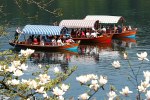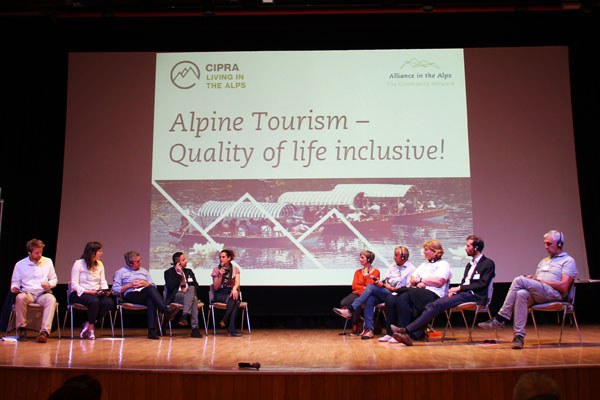News
Tourism: two sides of the same coin
People from all over the Alps and beyond met on 25 and 26 May 2018 in the Slovenian town of Bled for the annual conference of CIPRA International, CIPRA Slovenia and the “Alliance in the Alps” network of municipalities. Under the title “Alpine tourism: quality of life included!”, over 200 participants discussed how sustainable tourism can make a contribution to good living in the Alps – and what are the hazards of excessive tourism.
The conference venue, Bled, is a classic example: its idyllic location on a lake and its historic castle have made this 8,000-strong municipality in the Slovenian Alps a magnet for tourists, who come in droves from all over the world: along with the main cities, it now forms an essential part of any European tour. With its 8,000 hotel beds, the population of Bled doubles during the high season. While this means good money, the municipality sees little of it: most flows to the state or to foreign investors.
Some of the problems of the growth in tourism are reflected in Bled, as in other Alpine municipalities: “Only if tourism avoids exploiting nature and people can it be sustainable,” stated Katharina Conradin, President of CIPRA International, in her opening speech. Marc Nitschke, President of “Alliance in the Alps”, went further: “Tourism and quality of life cannot be allowed to cancel each other out.” This has now been demonstrated by various members of the association.
Dangerous growth spiral
Tourism indeed has many positive aspects, noted Jana Apih of Goodplace, a Slovenian association for sustainable tourism. People have never been so mobile as they are today, while every tenth person worldwide works in tourism, and there is growing prosperity in tourist regions. However, every hotel has a capacity limit – as do tourist attractions and destinations. As examples she pointed to such tourism hotspots outside the Alps as Venice, Barcelona and Amsterdam, where there is ever more resistance to mass tourism. Christian Baumgartner, Vice-President of CIPRA International, highlighted similar problems in the Alps, summarising his conclusions to the conference with “Twelve steps for a better quality of life in Alpine destinations”.
Increasing the quality of life in Alpine destinations – but how?
In Baumgartner’s view, “Sustainable solutions need to be developed together with local people”. Such solutions include visitor management, encouragement of overnight tourism, and discussion of capacity limits. Bled, according to its Director of Tourism, Tomaz Rogelj, is thus planning no further hotel beds: “We believe that we currently have the right number of beds to offer visitors what they want in Bled, namely tranquillity, nature and relaxation.” Locals too will be able to continue enjoying the benefits of Bled.
Baumgartner further underlined the importance of good working conditions and alternative business models in order to make working in tourism more attractive to local people. “It is clear that all ideas and offers must be equally attractive to visitors and locals alike.”
Participants held workshop discussions on the conflict lines in tourist destinations, such as nature conservation, the local economy and mobility. Possible solutions were also presented and developed, such as the promotion of natural diversity in municipalities, or new training and work models. Thanks to the inclusion of the “Living Labs” project, some 30 young people were also given the opportunity to take part in the conference. In all of the discussions every participant had a common goal in mind: finding ways to create a sustainable form of tourism for tomorrow that will contribute to the quality of life in the Alps.
The “Twelve steps for a better quality of life in Alpine destinations” can be found in document form on the websites of CIPRA and the “Alliance in the Alps”.
Sources and further information:
www.cipra.org/de/jft18 (de, it, fr, sl)




